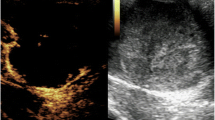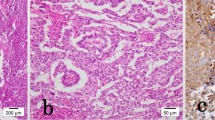Abstract
A 36-year-old male was referred to our hospital with left scrotal swelling. Computed tomography revealed a massive tumor in his left scrotum. The tumor extended along the gonadal vein extraperitoneally forming a massive tumor. Pathological examination showed a mixed-type germ cell tumor. Despite several chemotherapeutic treatments, the tumor continued to grow, and the patient died 28 months later after his first presentation at our institution. Autopsy revealed that the tumor comprised rhabdomyosarcoma and mature teratoma. We could not find useful tumor markers to facilitate the diagnosis of rhabdomyosarcoma. However, we recommend rebiopsy or palliative operation as options for re-diagnosis in case of resistant germ cell tumor. Here, we present a case of testicular tumor that exhibited different pathological examination results before and after treatment.






Similar content being viewed by others
References
Motzer Robert J, Amsterdam Alison, Prieto Victor et al (1998) Teratoma with malignant transformation: diverse malignant histologies arising in men with germ cell tumors. J Urol 159:133–138
Scavuzzo A, Santana Rios ZA, Reynoso Noveron N et al (2014) Growing teratoma syndrome. Case Rep Urol 2014:139425
Gorbatiy V, Spiess P, Pisters S et al (2009) The growing teratoma syndrome: current review of the literature. Indian J Urol 25:186–189
Logothetis CJ, Samuels ML, Trindade A et al (1982) The growing teratoma syndrome. Cancer 50:1629–1635
Comiter CV, Kibel AS, Richie JP et al (1998) Prognostic features of teratomas with malignant transformation: a clinicopathological study of 21 cases. J Urol 159:859–863
Giannatempo P, Pond GR, Sonpavde G et al (2016) Treatment and clinical outcomes of patients with teratoma with somatic-type malignant transformation: an international collaboration. J Urol 96:95–100
Oberlin O, Rey A, Lyden E et al (2008) Prognostic factors in metastatic rhabdomyosarcomas: results of a pooled analysis from United States and European cooperative groups. J Clin Oncol 26:2384–2389
Meza JL, Anderson J, Pappo AS et al (2006) Analysis of prognostic factors in patients with nonmetastatic rhabdomyosarcoma treated on intergroup rhabdomyosarcoma studies III and IV: the Children's Oncology Group. J Clin Oncol 24:3844–3851
Breneman JC, Lyden E, Pappo AS et al (2003) Prognostic factors and clinical outcomes in children and adolescents with metastatic rhabdomyosarcoma—a report from the intergroup rhabdomyosarcoma study IV. J Clin Oncol 1:78–84
Spiess PE, Kassouf W, Brown GA et al (2007) Surgical management of growing teratoma syndrome. The J Urol 177:1330–1334
Mitsuru Miyachi, Kunihiko Tsuchiya, Hideki Yoshida et al (2010) Circulating muscle-specific microRNA, miR-206, as a potential diagnostic marker for rhabdomyosarcoma. Biochem Biophys Res Commun 10:89–93
Masahiro M, Ikuyoshi H, Shigeyuki Y (2000) CA19-9 producing testicular tumor: a case report. Acta Urol Jpn 46:45–47
Tsuruta T, Ogawa A, Ikado S et al (1997) CA19-9: a possible serum marker for embryonal carcinoma. Urol Int 58:20–24
Indraneel B, Vinay T, Sher S et al (2016) Role of urinary and serum carbohydrate antigen 19–9 as a biomarker in diagnosis of adult giant hydronephrosis. J Clin Diagn Res 10:8–11
Meyer A, Kausch I, Kruger S et al (2004) Elevation of CA19-9 in giant hydronephrosis induced by a renal calculus. Urology 63:381–382
Korfel A, Fischer L, Foss H-D et al (2001) Testicular germ cell tumor with rhabdomyosarcoma successfully treated by disease-adapted chemotherapy including high-dose chemotherapy: case report and review of the literature. Bone Marrow Transplant 28:787–789
Funding
None.
Author information
Authors and Affiliations
Corresponding author
Ethics declarations
Conflict of interest
The authors declare that they have no conflict of interest.
Ethical approval
All procedures performed in studies involving human participants were in accordance with the ethical standards of the Ishikawa Prefectural Central Hospital Institutional research committee and with the 1964 Helsinki declaration and its later amendments or comparable ethical standards.
Informed consent
Informed consent was obtained from all individual participants included in the study.
Additional information
Publisher's Note
Springer Nature remains neutral with regard to jurisdictional claims in published maps and institutional affiliations.
About this article
Cite this article
Nakagawa, R., Aoyama, S., Urata, S. et al. Testicular rhabdomyosarcoma after chemotherapy for metastatic germ cell tumors. Int Canc Conf J 8, 175–180 (2019). https://doi.org/10.1007/s13691-019-00378-2
Received:
Accepted:
Published:
Issue Date:
DOI: https://doi.org/10.1007/s13691-019-00378-2




